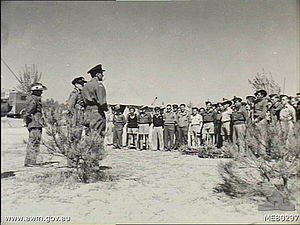- No. 454 Squadron RAAF
-
No. 454 Squadron RAAF 
Members of No. 454 Squadron RAAF celebrate Anzac Day in Cesenatico, ItalyActive 23 May 1941 – 11 July 1941
2 April 1942 – 20 August 1945Country  Australia
AustraliaAllegiance  United Kingdom
United KingdomBranch  Royal Australian Air Force
Royal Australian Air ForceRole Bomber Squadron Part of No. 201 Group RAF, Middle East Command
Desert Air ForceBattle honours
- South-East Europe, 1942–1945
- Mediterranean, 1940–1943
- Italy, 1943–1945
- Gustav Line
- Gothic Line
Aircraft flown Bomber Bristol Blenheim
Martin BaltimoreNo. 454 Squadron of the Royal Australian Air Force was formed during World War II. 454 Squadron came into existence at Williamtown in New South Wales on 23 May 1941. The squadron was raised under the Empire Air Training Scheme.
Contents
History
Formation
The squadron was destined for service in Europe with the Royal Air Force. It was, however, disbanded on 11 July, and its personnel dispersed between 456, 457 and 458 Squadrons.
Middle East
454 Squadron was given a second lease of life on 30 September 1942 when it was reformed as a light bomber squadron at RAF Aqir in Palestine. It proceeded to Iraq where, equipped with Bristol Blenheims, it joined a force intended to counter German threat from the Caucasus. Based at Qaiyara, Iraq the squadron flew no operational missions and instead served to provide refresher training on the Blenheim for crews being posted to other RAF squadrons.
In February 1943 454 Squadron moved to RAF El Amiriya in Egypt, where it joined 201 Group of the RAF's Middle East Command. Having left its Blenheims in Iraq, the squadron was equipped with Martin Baltimores. It commenced operations as a maritime patrol squadron and spent the next 17 months working in this capacity over the Mediterranean Sea – its main targets were enemy submarines and merchant shipping. It was also used for long-range reconnaissance and occasionally employed in strikes against land targets in Crete and the Greek islands. During this period 454 Squadron operated from several airfields including Amiriya, LG.143/Gambut III, RAF St Jean and Berka III.
Italy
In July 1944 The squadron relocated to Pescara in Italy and joined the Desert Air Force. Its role now changed to providing air support for the ground forces engaged in the Italian campaign, generally in the form of concentrated pattern bombing. Operating from a succession of airfields, 454 Squadron earned a reputation for efficiency, despite Italy's climatic extremes. In addition to its ground support missions, the squadron also attacked targets, experimented with radar-controlled bombing techniques, and, in early 1945, harried the retreating German forces by night. The squadron's war ended with the surrender of German forces in Italy on 2 May 1945 and it was disbanded at Villaorba on 14 August 1945.
During the war the squadron suffered 60 Australian fatalities.[1]
Aircraft operated
Aircraft operated by no. 454 Squadron RAAF, data from[2][3][4] From To Aircraft Version November 1942 January 1943 Bristol Blenheim Mk.IV February 1943 September 1943 Martin Baltimore Mk.III June 1943 December 1944 Martin Baltimore Mk.IV October 1943 August 1945 Martin Baltimore Mk.V Commanding officers
Officers commanding no. 454 Squadron RAAF, data from [5] From To Name 16 October 1942 16 November March 1943 Squadron Leader Ian Lindsay Campbell, RAAF 16 November April 1943 1 April 1944 Wing Commander John Arthur Gordon Coates, CBE, DFC, MID, RAF 1 April 1944 25 November 1944 Wing Commander Milton 'Mike' Jeffery Moore, DFC, RAAF 25 November 1944 18 May 1945 Wing Commander Andrew Dil 'Pete' Henderson, OBE, MID, RAAF 19 May 1945 14 August 1945 Wing Commander John Gordon Rees, DFC, DFC(US), RAAF See also
Notes
- ^ Australian War Memorial: 454 Squadron RAAF, Accessed 25 October 2007
- ^ Moyes 1976, p. 252.
- ^ Halley 1988, p. 476.
- ^ Jefford 2001, p. 94.
- ^ 454 Squadron: Our History
References
- Halley, James J. The Squadrons of the Royal Air Force & Commonwealth 1918–1988. Tonbridge, Kent, UK: Air Britain (Historians) Ltd., 1988. ISBN 0-85130-164-9.
- Jefford, Wing Commander C.G., MBE, BA, RAF(Retd.). RAF Squadrons, a Comprehensive record of the Movement and Equipment of all RAF Squadrons and their Antecedents since 1912. Shrewsbury, Shropshire, UK: Airlife Publishing, 1988 (second edition 2001). ISBN 1-85310-053-6.
- Lax, Mark (2006) To The Alps: 454 Squadron RAAF 1941–1945.
- Moyes, Philip J.R. Bomber Squadrons of the RAF and their Aircraft. London: Macdonald and Jane's (Publishers) Ltd., 2nd edition 1976. ISBN 0-354-01027-1.
External links
Related content
Main series 1 · 2 · 3 · 4 · 5 · 6 · 7 · 8 · 9 · 10 · 11 · 12 · 13 · 14 · 15 · 20 · 21 · 22 · 23 · 24 · 25 · 26 · 27 · 28 · 29 · 30 · 31 · 32 · 33 · 34 · 35 · 36 · 37 · 38 · 40 · 41 · 42 · 43 · 60 · 66 · 67 · 71 · 73 · 75 · 76 · 77 · 78 · 79 · 80 · 82 · 83 · 84 · 85 · 86 · 87 · 92 · 93 · 94 · 99 · 100 · 102 · 107 · 292 · Fighter · Rescue and Communication · Seaplane · Berlin Air Lift
Article XV squadrons Joint Netherlands-Australian squadrons Categories:- RAAF squadrons
- Military units and formations established in 1941
- Article XV squadrons of World War II
Wikimedia Foundation. 2010.
